Browse Primary Sources
Locate primary sources, including images, objects, media, and texts. Annotations by scholars contextualize sources.
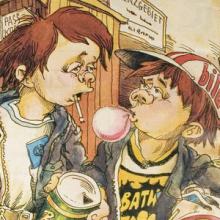
Political Cartoon from East Germany
Twenty-eight years I've had to wait for this day, eh!
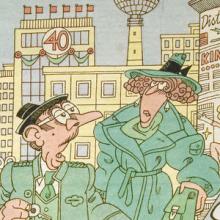
East German Political Cartoon
This cartoon from the East German weekly magazine Eulenspiegel (a weekly magazine of humor and satire), is poking fun at the possibility of German reunification. Once the Berlin Wall was torn down, unification became the goal of most (but not all) Germans on both sides of the border.
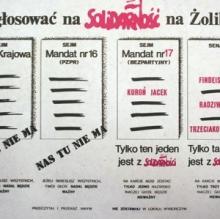
Solidarity Election Flier, “How to vote for Solidarity in Żoliborz”
The flier above, directed at voters in the town of Żoliborz, illustrates the complexity of the elections held on June 4, 1989.

Papal Visit of 1987
When Pope John Paul II arrived in Warsaw during his 1987 "pilgrimage" he drove from the airport to the Primate's palace. A huge crowd turned out to greet him and flowers were laid out along the street that he was scheduled to travel. This pattern was repeated throughout his visit, wherever he went.
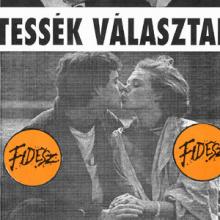
Tessek Valasztani
This is one of many posters used during the 1990 Hungarian election by new political parties to differentiate themselves from the Communist Party. Here, voters are asked to "choose" between two different types of kisses. The poster was used by the party Fidesz (Alliance of Young Democrats).
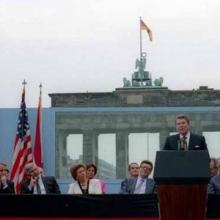
Reagan at the Berlin Wall
On June 12, 1987, President Ronald Reagan gave an historic speech to the people of Berlin. It was here that Reagan spoke the famous phrase: "General Secretary Gorbachev, if you seek peace, if you seek prosperity for the Soviet Union and Eastern Europe, if you seek liberalization: Come here to this gate! Mr. Gorbachev, open this gate! Mr. Gorbachev, tear down this wall!"
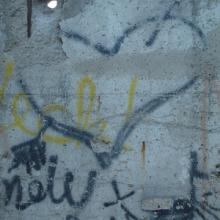
Berlin Wall Memorial at the Baker Institute (Rice University)
In 2000, 11 years after the fall of the Berlin Wall, Rice University installed a section of the wall as a permanent part of the Baker Institute.
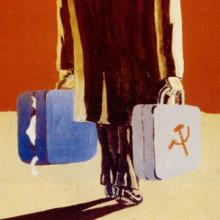
Goodbye, Comrade...
Of all of the East Central European revolutions, only Romania's turned violent. After government security forces killed protesters in the city of Timisoara, violence broke out between the army and the secret police, with the army standing by the protesters.

Berlin 9 November 1989
With the regime in disarry, an announcement that travel restrictions would be liberalized led East Germans to rush for the wall; confused guards let them pass, and by nightfall, Berliners from both sides had converged on the hated barrier and begun chipping away. This poster was sold in a (West) Berlin souvenir shop after 1989.
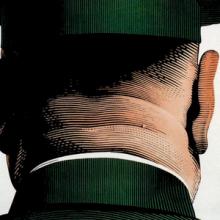
Comrades - It's Over!
Poster circulated by the anticommunist organization, Hungarian Democratic Forum (MDF) in the summer 1989 marking the anticipated departure-eviction of the Soviet Red Army troops who had kept Hungary in the Soviet bloc since the end of World War II.
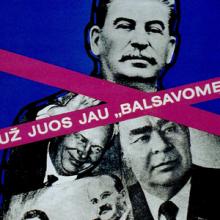
For Them We Have Already "Voted"
March 1989 election poster for the nationalist "Sajudis" movement in Lithuania, wryly alluding to the Soviet leaders pictured here - Stalin, Molotov, Khrushchev, and Brezhnev - whose rule had been imposed on the Baltic countries since World War II and ratified through sham elections.

It Must Not Happen Again (1)
One of a set of posters reflecting glasnost-era exposès of the crimes of the Stalin era - including collectivization, purges, and the gulag. The quotation from Pravda (5 April 1988) reads: "The guilt of Stalin, as well as the guilt of those around him, toward the party and people for the mass purges [and] lawlessness [they] committed is huge and unforgivable."

It Must Not Happen Again (2)
One of a set of posters reflecting glasnost-era exposès of the crimes of the Stalin era - including collectivization, purges, and the gulag. The quotation from Pravda (5 April 1988) reads: "The guilt of Stalin, as well as the guilt of those around him, toward the party and people for the mass purges [and] lawlessness [they] committed is huge and unforgivable."
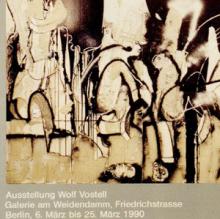
Wolf Vostell - 9 November 1989
A more abstract image of the night the wall fell appears in this painting by an artist whose work had also appeared on the western side of the wall itself. This painting represented a March 1990 show of Vostell's work in a gallery in East Berlin - formerly a bastion of "socialist realist" art hailing the communist regime.
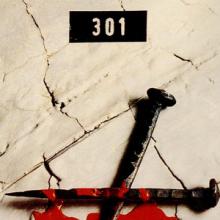
301
A poster distributed by the Alliance of Free Democrats (SZDSZ), a liberal political party founded in 1988 in opposition to the Communist Party in power in Hungary. This poster alludes to the martyrs of the 1956 Soviet invasion to put down the Hungarian revolution.

Against Pig-Headedness and Corruption
Poster criticizing the Stasi - the GDR secret police - prior to March 18, 1990 East German election in which voters overwhelmingly backed unification with West Germany. The red letters in the poster "GEGEN STARRSINN UND KORRUPTION" - "AGAINST PID-HEADEDNESS AND CORRUPTION" - spell out the name of the hated secret agency, and the number "18" alludes to the upcoming balloting.
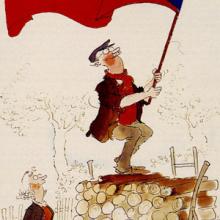
"...Climb Down and Get to Work!"
In Spring 1990, Czechoslovak artist and cartoonist Vladimir Rencin sends this message that is was time to stop the flag-waving euphoria surrounding the revolution's victory and to get to the hard work of rebuilding the country. The caption reads: "It's high time for you to climb down and get to work!

Vote With Us
A poster distributed by the Polish opposition party Solidarity, urging Poles to vote with them against the Communists in the election on June 4, 1989. Solidarity won the election in a landslide inaugurating the first non-communist government in East Central Europe in more than four decades.
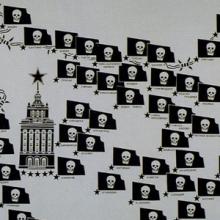
45 Years is Enough!
While the world watched the events in Berlin, another Soviet ally in East-Central Europe suddenly collapsed: On November 9-10, after three-and-a-half decades in power, Bulgarian communist leader Todor Zhivkov was unceremoniously dumped. This poster - a map of the Bulgarian gulag - was circulated by the opposition Union of Democratic Forces during the spring 1990 election campaign.
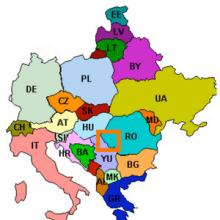
Eastern and Central Europe After 1989
The nations formed following the break up of the Soviet Union. The Soviet Union is no longer on this map. It has been replaced by several new independent states—Moldova and Ukraine among them. The former Yugoslavia has also fragmented into several states.